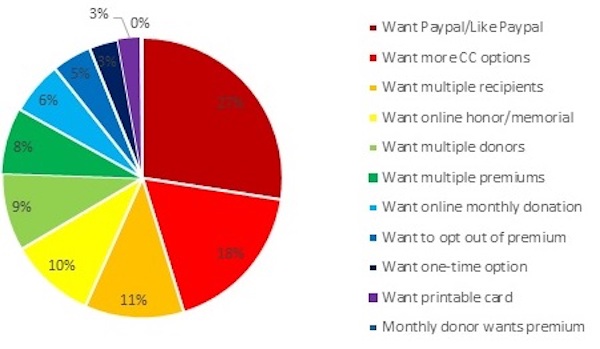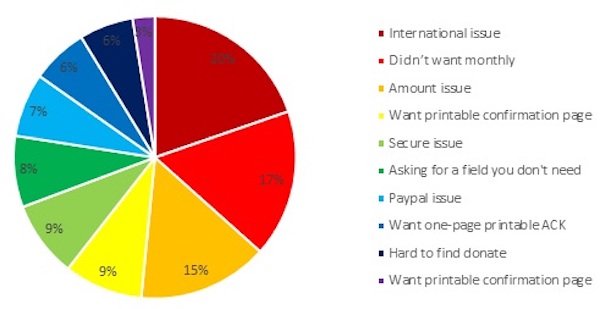Your nonprofit is working day and night to cultivate donors: your site is up-to date, your calls to actions are bold and motivational, you are leveraging numerous social platforms to expand your online presence, and you are mailing consistent well crafted direct mail appeals. So why aren’t you getting any, or not as many as you’d like, donations online?
This is an issue we see with many nonprofit organizations. Their content and outreach strategy appears to be impeccable, but for some reason it’s not converting into contributions.
What’s the hitch?
ONLINE GIVING STATS
Most likely, your online giving process (aka the user experience) is a key factor. In a recent survey by The Agitator, it was found that most donors are not impressed with the online giving process. In the chart below, they divided up donors’ major concerns:

As you can see from the chart, 45% of donors are begging for new payment options. In a previous post, we detailed how having convenient payment options is key to attracting and maintaining donors, specifically millennials. If your nonprofit is asking for donations via check or is utilizing an outdated platform, it’s time for an update. According to a study by BizRate, your best option is may be PayPal:
PayPal remains a very important payment option for younger shoppers. PayPal’s own research shows that 32% of millennials use PayPal and 25% of them prefer to use it for paying and receiving money. Among that group, 42% prefer using PayPal on their smartphone.
ONLINE DONATION FORMS
Another reason your donation process may be hindering your success is because of the complicated nature of your donation forms. Here are a few of the biggest reasons your donation process is turning away potential donors:

International giving is by far the largest area of difficulty for donors. Many nonprofits, especially those in the United States, forget that the American dollar may not be the only form of currency flowing through their donation page. Not only do many nonprofits forget to include foreign currency options, but they also forget that different countries have various postal and address formats. Not only do donors struggle to give their gift, but they can’t even properly identify themselves.
As a nonprofit, it is crucial that you open up your donation platform to a wide range of donors. There’s a high chance your donation rate will increase.
TOO MANY FIELDS
Last but not least, let’s address the issue of superfluous fields. Conversion rates drop with each added field. From the chart, you can see that there is a considerable percentage of donors who do not appreciate the extra fields they are required to fill out in order to give a gift. In a survey by The Agitator, people listed a few of the fields that annoy them the most:
- Title
- Phone number
- How did you hear about us?
- Address
- Birthdate
- City, state, ZIP
- Last name
Although, depending on the type of donation and the credit card processor, information like last name or address may be necessary, consider removing as much as possible from the process. As Leonardo Da Vinci once stated: “Simplicity is the ultimate sophistication.”
So, if you seem to be doing everything right but the results are going terribly wrong, take a look at your online donation process. Fundraising success may be just a few tweaks away.


